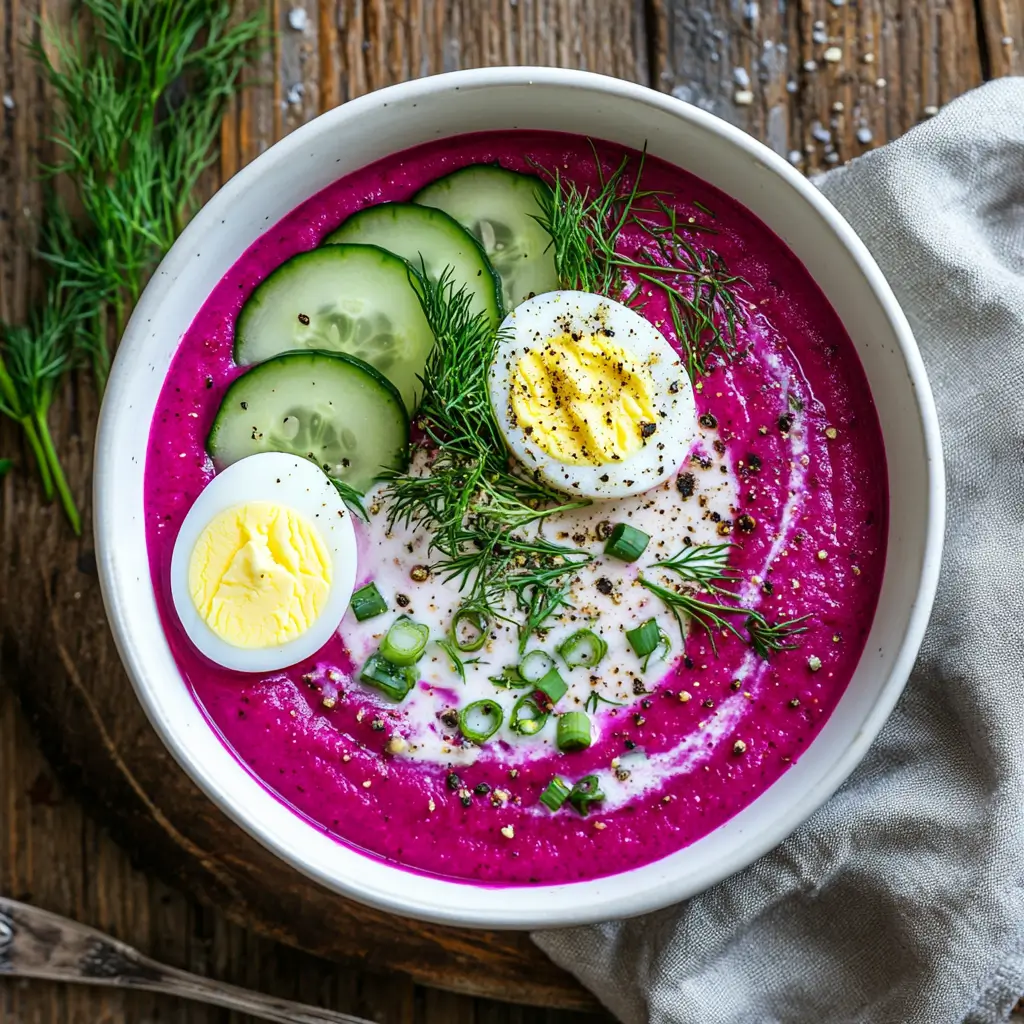1: The Story & Intro
Cold beet soup is more than just a pretty dish—it’s a vibrant, chilled bowl of comfort with deep cultural roots and a refreshingly modern twist. In this article, you’ll learn what makes cold beet soup a standout summer favorite, how to make it at home, and why it deserves a place at your table. We’ll also explore its Lithuanian and Latvian origins, its health perks, and how it connects cultures from Eastern Europe to your kitchen. Whether you’re craving something light or looking to try something new, this chilled soup is both flavorful and easy to love.
Table of Contents
Table of Contents
Beets and Summer Memories
Cold beet soup holds a special place in Sam’s heart. He first tasted it in a Lithuanian countryside village during a warm July afternoon. A neighbor offered a bowl of bright pink soup, chilled to perfection and topped with a swirl of sour cream and fresh dill. Sam—then a curious young cook freshly returned from kitchen stints in Paris—was captivated. The soup was tangy, earthy, and cooling. In short, it was everything a summer dish should be.
Print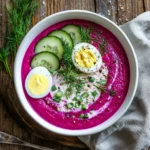
Cold Beet Soup Recipe: A Refreshing Classic with a Global Story
- Total Time: 50 minutes
- Yield: 4 servings
- Diet: Vegetarian
Description
Cold Beet Soup is a refreshing and colorful chilled dish made with cooked beets, kefir or yogurt, cucumbers, dill, and scallions. This Eastern European classic is perfect for warm weather and packed with fresh, tangy flavor. It’s naturally gluten-free, easy to adapt for a vegan diet, and comes together in under an hour.
Ingredients
3–4 medium beets, boiled, peeled, and grated or diced
2 cups kefir or buttermilk (or dairy-free yogurt for vegan)
1 medium cucumber, diced
2–3 scallions, chopped
1 bunch fresh dill, chopped
2 hard-boiled eggs, sliced (optional)
1–2 tablespoons lemon juice or white vinegar
Salt and pepper, to taste
Instructions
Boil the beets in water for 30–40 minutes or until tender. Drain, cool, peel, and grate or dice them.
In a large bowl, whisk kefir or buttermilk with lemon juice or vinegar. Add salt and pepper to taste.
Mix in the beets, cucumber, scallions, and dill. Stir until fully combined.
Chill the soup in the refrigerator for at least 1–2 hours.
Serve cold with sliced hard-boiled eggs and extra dill, if desired.
Notes
Store in an airtight container in the fridge for up to 3 days.
Add chopped pickles or radish for extra crunch.
For vegan: use plant-based kefir or unsweetened yogurt and skip the eggs.
Serve with rye bread or boiled potatoes for a traditional meal.
- Prep Time: 10 minutes
- Cook Time: 40 minutes
- Category: Soup
- Method: Boiling, Mixing, Chilling
- Cuisine: Lithuanian, Eastern European
Years later, cold beet soup remained a staple in his travels and menus, from New York diners to Southeast Asian food stalls. When Sam started Fresh Leaf Recipes, he knew this dish belonged on the list. It’s not just traditional—it’s adaptable, beautiful, and satisfying.
Why Cold Beet Soup Deserves a Spot at Your Table
Let’s face it—beets don’t always get the love they deserve. But cold beet soup is the gateway to changing that. The beets are usually boiled and then cooled, bringing out their natural sweetness without the earthy bitterness. Combine that with tangy kefir or yogurt, crisp cucumbers, scallions, chopped eggs, and a handful of dill, and you’ve got a flavor-packed dish that’s as satisfying as it is healthy.
This chilled soup is light but filling, creamy yet refreshing, and it’s incredibly versatile. You can swap out dairy for a vegan base, add radishes for extra crunch, or even adjust the acidity with lemon or vinegar to suit your taste. It’s a true canvas for creativity.
As summer approaches, cold beet soup becomes a smart way to stay nourished and cool. Plus, it’s make-ahead friendly. A big batch in the fridge means instant meals that don’t require turning on the stove again.
Coming up next: we’ll walk through the exact ingredients and easy steps so you can make cold beet soup in your own kitchen with confidence.
2:Cold Beet Soup Ingredients & Prep Guide
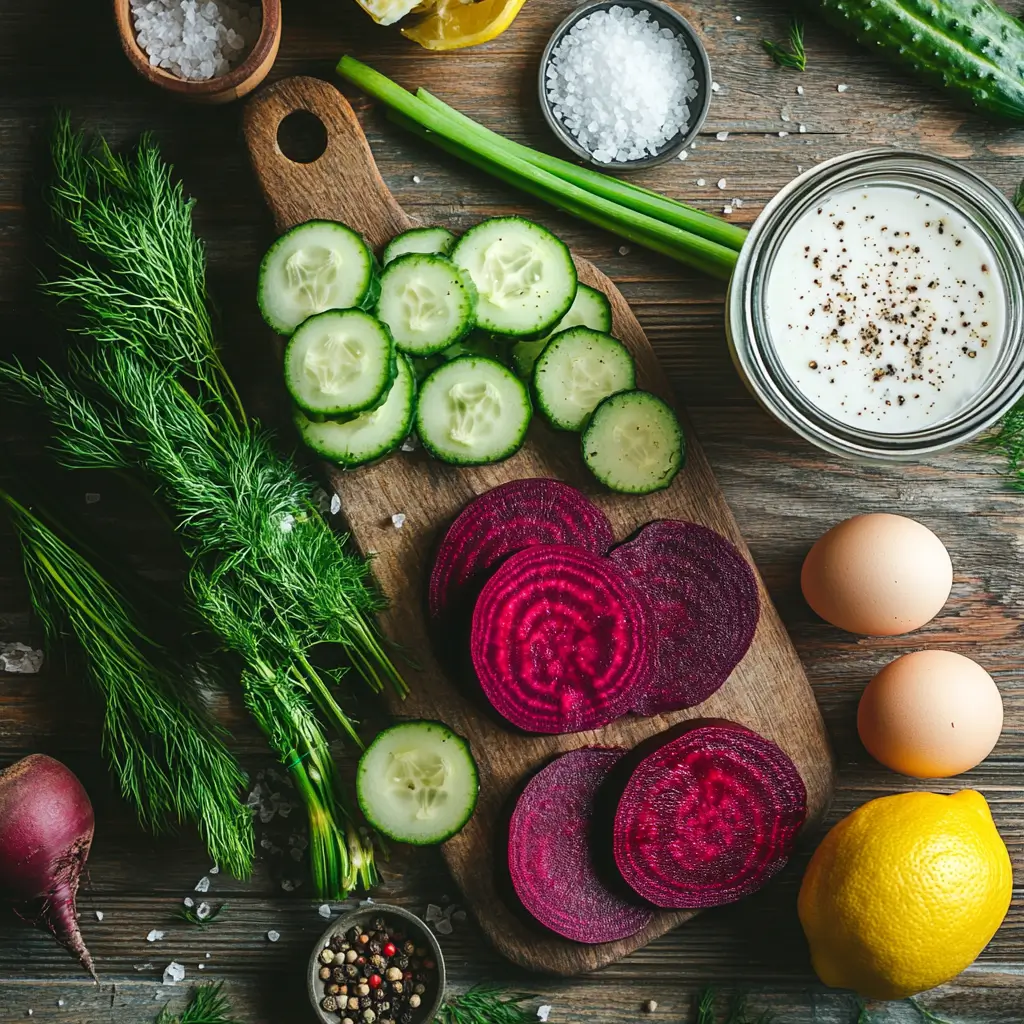
What You’ll Need: Core Ingredients for Cold Beet Soup
Making cold beet soup at home is much easier than it looks, and you don’t need any fancy ingredients. The real magic comes from using fresh, good-quality produce. Here’s a breakdown of what you’ll need to whip up a batch:
| Ingredient | Purpose |
|---|---|
| Beets (3–4 medium) | The star ingredient, cooked and chilled |
| Kefir or buttermilk | Adds creaminess and tang |
| Cucumber (1 medium) | Crunchy, refreshing texture |
| Scallions (2–3) | Mild onion flavor |
| Fresh dill (1 bunch) | Signature herb that adds brightness |
| Hard-boiled eggs (2) | Optional, for extra richness |
| Salt and pepper | For seasoning |
| Lemon juice or vinegar | Boosts acidity and sharpness |
Start by boiling the beets until tender (about 30–40 minutes), then peel and grate or dice them once cooled. You can also roast them if you prefer deeper flavor, but boiling keeps the soup lighter. The rest is a simple mix-and-stir process—no blending or fancy tools needed.
Cold beet soup is flexible. If you’re going dairy-free, swap kefir for unsweetened coconut yogurt or a mix of cashew milk and lemon juice. Want more protein? Add chopped ham or tofu cubes. It’s easy to adjust to your taste and dietary needs.
Simple Steps to Make It at Home
Once your beets are cooked and cooled, making cold beet soup is a simple three-step process:
- Prepare the Base: In a large bowl, combine 2 cups of kefir or buttermilk with 1–2 tablespoons of lemon juice or vinegar. Whisk until smooth. Season with salt and pepper.
- Add the Mix-Ins: Stir in your grated beets, diced cucumber, chopped scallions, and fresh dill. Adjust the seasoning again, and taste as you go.
- Chill and Serve: Let the soup rest in the fridge for at least 1–2 hours. This helps all the flavors meld together. Serve cold, garnished with sliced hard-boiled egg and extra dill.
This soup holds well in the fridge for up to 3 days, and the flavor improves as it sits. It’s a great dish to prep ahead for a hot week, lunchbox meals, or an elegant dinner starter.
Next up, we’ll explore where this soup comes from—and why so many countries claim it as their own.
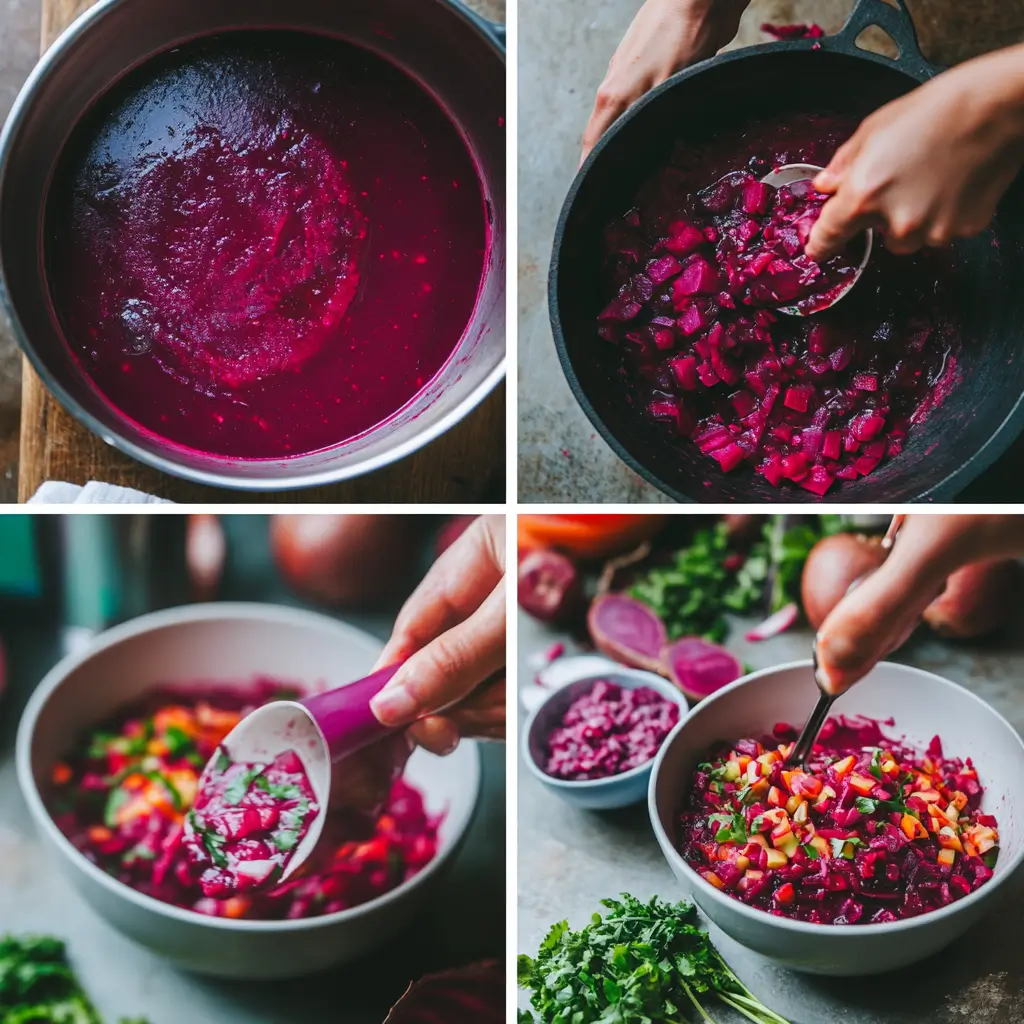
3:Variations & Cultural Roots of Cold Beet Soup
Is Cold Beet Soup Lithuanian or Latvian?
Cold beet soup has sparked a friendly culinary debate between Lithuania and Latvia—and for good reason. Both countries claim deep-rooted traditions around this chilled, magenta-hued dish. In Lithuania, it’s called šaltibarščiai, often made with kefir and served with warm boiled potatoes on the side. Latvians have their own spin, sometimes incorporating sour cream and slightly different herbs or garnishes, but the essence remains the same: beets, dairy, freshness.
So, who gets the credit? The truth is, cold beet soup is celebrated across much of Eastern Europe—from Poland and Belarus to Ukraine and Russia. Its variations reflect local ingredients, preferences, and history. But in terms of global recognition, Lithuania’s version has arguably become the best-known. Even Lonely Planet dubbed šaltibarščiai “one of the world’s most colorful soups.”
If you’re curious about how other cultures reinterpret classic dishes, you’ll appreciate similar regional spins in our Asian noodle soup guide or Italian sausage soup. They show how tradition and flavor evolve, even when the base ingredients stay simple.
Whether you lean Latvian or Lithuanian, cold beet soup reflects the power of local food traditions passed down through generations—and it tastes even better when shared with family and friends.
From Borscht to Šaltibarščiai: What’s the Difference?
A common question we get is: Is cold beet soup just borscht served chilled? Not quite. While both feature beets as the primary ingredient, their texture, flavor profile, and preparation differ significantly.
Borscht—originating from Ukraine—is typically a hearty, savory, hot soup. It’s often simmered with beef or pork bones, cabbage, potatoes, and tomatoes. While there are cold versions of borscht (like Polish chłodnik), they still tend to lean more brothy and spiced.
Cold beet soup, especially in the Lithuanian sense, is creamier and lighter. It doesn’t involve meat or broth, and it’s designed to be served cold from the start, not just cooled-down leftovers. It’s closer to a summer salad in soup form than a stew.
Think of it like comparing autumn squash soup to chicken broccoli cheese soup. Both are delicious and use similar base techniques, but they offer entirely different experiences.
If you’re looking for a plant-based alternative, the vegan mushroom soup on our site offers the same kind of comfort with a unique earthy twist.
Now that you know the cultural and culinary distinctions, let’s dig into how good cold beet soup really is for your health—and how long it keeps.
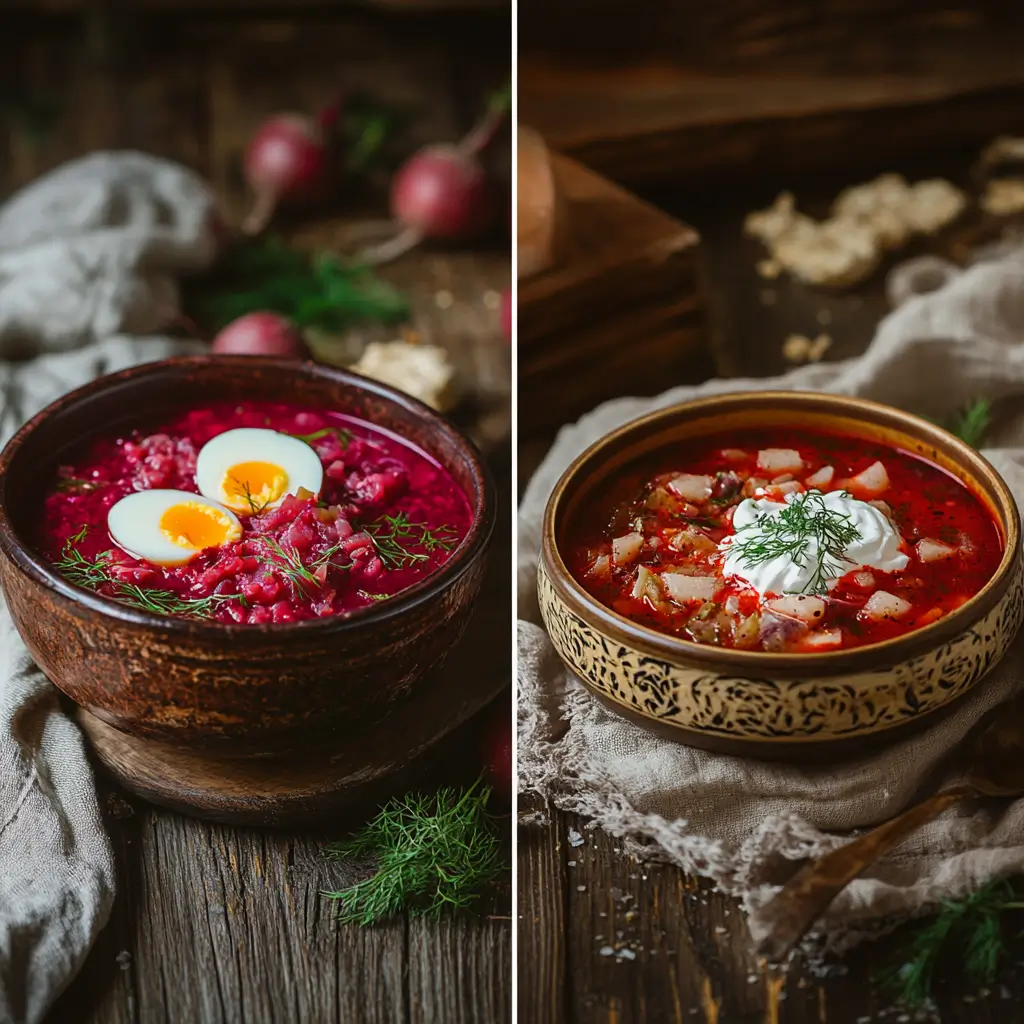
4:Health Benefits & Storage Tips
Is Cold Beet Soup Good for You?
Cold beet soup isn’t just tasty—it’s packed with nutritional benefits. Beets are a powerhouse ingredient, rich in fiber, folate, and antioxidants like betalains, which support liver health and may reduce inflammation. When combined with kefir or yogurt, the soup also delivers a solid dose of probiotics that support digestion and gut health.
Adding cucumbers, scallions, and fresh herbs like dill enhances the vitamin content, while hard-boiled eggs provide protein and satiety. The result is a well-balanced, nutrient-dense dish that feels indulgent without being heavy.
For anyone following a lighter eating plan or looking to add more whole foods into their diet, cold beet soup is a smart and satisfying choice. It’s naturally gluten-free and easily adaptable to be vegan or dairy-free. Simply substitute the kefir with a plant-based yogurt alternative, and you’ve got a completely plant-based meal.
Looking for more feel-good soups? Check out the velveeta broccoli cheese soup for a cozy option or explore our asparagus soup recipe that’s just as springy and nourishing.
How to Store, Freeze, and Enjoy Later
One of the best things about cold beet soup is its make-ahead friendliness. After preparing and chilling your batch, store it in an airtight container in the refrigerator. It keeps well for up to 3 days, and the flavor actually improves as the ingredients meld.
If you’re planning to freeze it, keep in mind that dairy-based soups can separate when thawed. To get around this, freeze the beet and vegetable mix separately and stir in the dairy base once thawed. This keeps the texture smooth and prevents any graininess.
When serving leftovers, give the soup a good stir and adjust seasoning as needed. A fresh squeeze of lemon or an extra sprinkle of dill can bring the flavors back to life. And don’t forget to pair it with something warm—many people enjoy it alongside a slice of rye bread or a potato-based dish.
For more storage-friendly recipes, try our chicken broccoli cheese soup or browse ideas in the main soup category for more inspiration.
Coming up: answers to common questions people ask about cold beet soup—and how to enjoy it your way.
5:FAQ: Everything You’ve Wondered About Cold Beet Soup
What is cold beet soup?
Cold beet soup is a refreshing, chilled dish made primarily from cooked beets, tangy dairy like kefir or yogurt, and fresh vegetables such as cucumbers, scallions, and dill. It’s popular in Eastern European countries and is typically served cold, often with hard-boiled eggs or warm potatoes on the side. It’s creamy, vibrant, and ideal for summer.
Is cold beet soup Lithuanian or Latvian?
Both! Lithuania and Latvia each have their own version of cold beet soup. In Lithuania, it’s called šaltibarščiai, and it’s often made with kefir and served with boiled potatoes. Latvia has a similar version with minor ingredient differences. Both cultures consider it a summer staple.
Is cold beet soup good for you?
Yes, cold beet soup is very healthy. Beets are rich in fiber, folate, and antioxidants, while the kefir or yogurt provides beneficial probiotics. The soup is light, hydrating, and loaded with nutrients from fresh vegetables and herbs. It can also be adapted for various dietary needs.
Can you eat borscht cold?
You can, but it depends on the version. Traditional Ukrainian borscht is typically served hot and includes meat and root vegetables. However, there are cold variations of borscht, like Polish chłodnik, that resemble cold beet soup in texture and preparation.
What’s the difference between beet soup and borscht?
Borscht usually refers to a hot, hearty soup made with beets, meat, and cabbage, often slow-simmered. Cold beet soup, especially Lithuanian šaltibarščiai, is lighter, dairy-based, and served chilled. The texture and flavor are completely different.
What country eats beetroot soup?
Many countries do, especially in Eastern and Central Europe. Lithuania, Latvia, Ukraine, Russia, Poland, and Belarus all have regional variations of beetroot soup, each with its own twist on ingredients and preparation. Cold beet soup is especially popular in Lithuania.
for mor recipes follow me in facebook and pinterest
6:Conclusion
Cold beet soup brings together simplicity, tradition, and flavor in one vibrant bowl. Whether you’re looking to cool down on a hot summer day or try a dish from a rich cultural heritage, this soup delivers. It’s quick to prepare, endlessly customizable, and full of nutrients. From Sam’s first taste in Lithuania to his own kitchen table, this soup has always been about more than just ingredients—it’s about sharing something fresh, familiar, and real.
So grab your beets, chill your kefir, and try it for yourself. Cold beet soup might just become your new warm-weather favorite.

